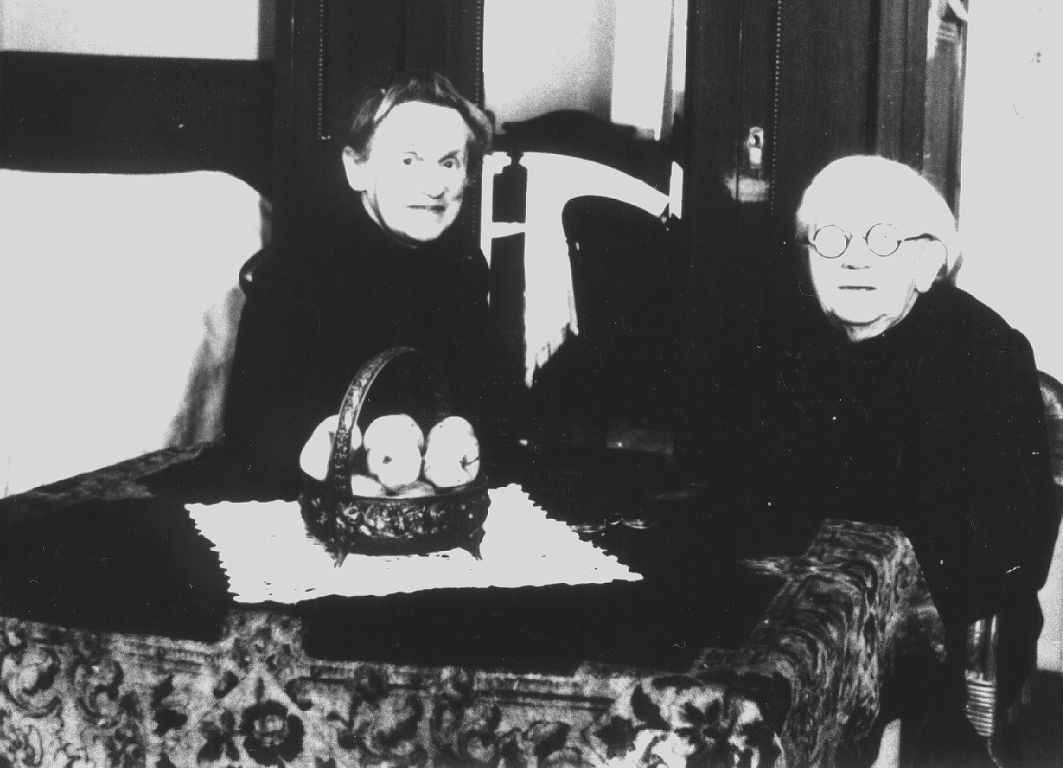 EINSTEIN,
Mina ("Minnele"),
EINSTEIN,
Mina ("Minnele"),
The Jewish
Community
of
La
Book Pages 186 - 188
KARL
NEIDLINGER
Mina Einstein, born September 6, 1872, in Laupheim, unmarried, "Haustochter".
Deported to Theresienstadt on August 19, 1942, where she died on November 8, 1942.
"I can remember Minnele Einstein well because whenever we had a fire on the Judenäcker on the day of Passover, we collected wood for the fire, so the Chametz-fire would burn great and big. Once we took a few of her shutters off their hinges and threw them on the fire!"
(Tale by Ernest Bergmann, January 2007)


Let’s leave aside the question whether the "feat" during the wood collection
did actually happen as described above or whether Ernest Bergmann made his
memory sound a little more dramatic. Nowadays, it is hard to find
contemporary memories of single, elderly women who were never in the focus
of the public eye, which is why this quote has been put at the beginning of
this article.
Mina Einstein was the oldest daughter of livestock trader Moses Einstein
(1842-1926) and his wife Hännchen ("Hannele") May (1843-1903) from
Ichenhausen. She had three younger sisters: Berta, (born in 1847), Fanny
(born in 1875) and Anna (born in 1877). Bertha and Fanny married two
brothers from Traunstein and took the name Holzer; Anna got married in
Munich and took the name Neuburger. The youngest child and only boy, Ludwig
(born in 1880), had already died by 1916.
After their mother "Hannele" had passed away in early 1903, Mina, as the
oldest daughter, took over her role and ran the household. She was therefore
entered in official employment lists as a
Haustochter. As she was
indispensable at home, and also because her father Moses reached a blessed
old age of 84 years, marriage was out of the question for her. As all
livestock traders had employees, it is possible that one of these employees
independently took care of the economic well-being of the family during the
20s, after the father had died in 1926. Additionally, Mina Einstein will
have rented a part of the big house she had lived in alone since 1926. In
1938, for example, a widow called Sofie Braunger stayed with her as a
tenant.
Bit by bit, Jews were socially excluded and deprived of their rights by the
NS-regime, whose inhuman brutality grew constantly. Already at the end of
1938, the government took houses and apartments especially from wealthy Jews
and forcibly relocated the residents to collective homes. Minnele Einstein’s
home in Kapellenstrasse was one of
these early collective homes. In his family chronicle, John Bergmann wrote
about the destiny of his aunts and uncles during the
Reichskristallnacht in 1938:
"When Edwin Bergmann returned from the concentration camp, he found that he could no longer live in his house at Querstrasse but was forced to live with his wife and son Walter at 49 Kapellenstrasse, in the home of Minelle Einstein. Aunt Emma Gideon and Clara Hofheimer joined them in their crowded quarters. (...) Waiting for her American visa, she spent the High Holy Days in September, 1939, with her sisters in Winterthur, but returned to Laupheim, only to find herself evicted from her house and sent to the ancient Rabbinate, 2 Judenberg, now converted to a home for the aged, which she had to share with more than forty old Jewish men and women."
(From: "The Bergmanns from Laupheim", page 99, f.)
Since October 4, 1939, Mina Einstein was also one of the 40 people who were
confined in the former rabbinate. The pictures of her were both taken in
this place. It remains unknown if there were any attempts to leave Germany.
She was carted off from the retirement home during the last deportation on
August 19, 1942, to the concentration camp Theresienstadt, where she
succumbed to the inhuman conditions on November 8, 1942.
Her home on Kapellenstrasse
immediately became property of the government after she had been deported
and was rented to several other people.
None of Minnelle's sisters had survived the war: Berta and Fanny Holzer had
died of natural causes, and Anna Neuburger, too, was a victim of the
holocaust. Their children, however, were all able to immigrate to the US in
time in 1937/1938, except Berta's daughter Ilse: In 1946, she lived in
Munich as Ilse Schuster and presumably survived the war and the genocide in
Germany.
Ilse Schuster, Munich; Klara Holzer, Oregon; Johanna Strauss and Fred
Neuburger, both New York, filed a restitution application in 1946 to the
French military government in Biberach to reclaim the house on 40
Kapellenstrasse as rightful heirs.
Even though the state of affairs was absolutely clear, it was not until
December 1951 that the house was finally returned to the four legal heirs,
due to the political developments after the war. They presumably sold the
house on the free market afterwards.
________
Sources:
Restitutionsakten Staatsarchiv Sigmaringen Wue 126/2, Nr. 21.
(eng: restitutionfiles state archive Sigmaringen Wuerzburg 126/2, No. 21.)
John H. Bergmann, The Bergmanns from Laupheim,1983 .
John-Bergmann-Nachlass, Leo-Baeck-Inst. NY, auf Mikrofilm im Stadtarchiv
Laupheim. Zeitzeugenberichte Ernest Bergman (e-mails, muendl.).
(eng: John-Bergmann-estate, Leo-Beack-Institute. NY, mircofilm in the city
archive of Laupheim. Witness accounts by Ernest Bergman (e-mails, verbal)
Adressbuch der Stadt Laupheim, 1938.
(eng: Address book of Laupheim, 1938.)
